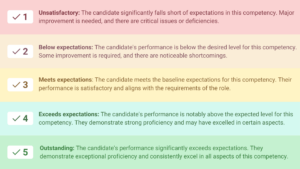Finding the perfect hire requires the perfect balance of skills, cultural fit, and so much more. This is where interview scorecards come into play, offering a structured approach to evaluating candidates.
Trust us, they’re a game-changer for bringing clarity and focus to your search!
Here’s how we’re breaking down everything you need to know about these handy tools:
- The lowdown on why interview scorecards are a must-have in your hiring process.
- A step-by-step guide to creating a scoresheet that nails your job criteria.
- Tips to sidestep common pitfalls and make the most of your scorecards.
And don’t miss out on the FREE interview scorecard example and PDF you can download for your hiring process!
What is an interview scorecard?

An interview scorecard is a standardized evaluation tool used during the recruitment process to assess candidates.
Unlike traditional note-taking, this method allows recruiters and hiring managers to systematically score candidates on various competencies and qualifications, including technical skills, problem-solving abilities, communication skills, cultural fit, and more.
This approach ensures that every candidate is evaluated objectively and consistently based on the same set of standards.
Key aspects of an interview scoresheet include:
- Criteria: Enumerates the competencies and qualifications necessary for the job.
- Scoring system: Employs a scale (e.g., 1-5) to assess each candidate’s fit for the criteria uniformly.
- Notes section: Provides space for interviewers to record observations or examples that justify the scores given.
Structured around these components, an interview scorecard is designed to streamline the evaluation process, allowing interviewers to focus on gathering relevant information that directly pertains to the job’s requirements.
Read more: How can recruiters assess candidates accurately?
Top 5 benefits of using an interview scorecard while hiring
Interview scorecards are a critical addition to the hiring process, offering a structured approach to evaluating candidates. They ensure decisions are made with a clear focus on what matters most.
Let’s look at a few more reasons why interview scorecards are a beneficial tool for recruiters:
1. Enhances objectivity and consistency in candidate evaluations
Interview scorecards systematically reduce unconscious bias by focusing evaluations on predefined, job-relevant criteria.
A study by the Harvard Business Review suggests that structured interviews that use scorecards are significantly more effective at predicting job performance and enhancing the objectivity of hiring decisions.
By evaluating all candidates against the same criteria, scorecards minimize biases, ensuring a fairer and more objective hiring process.
2. Encourages data-driven decision making
By quantifying candidate assessments, scorecards facilitate easier comparison and more informed decision-making.
In fact, using a data-driven approach in the recruitment process can save recruiters up to 23 hours of manual labor a week through candidate pre-screening and shortlisting.
Recruitment teams can also make comparisons and decisions based on consistent, numerical evidence rather than intuition alone.
Over time, this data can be analyzed to identify patterns, predict hiring success, and refine the recruitment process for better outcomes.
3. Reduces time-to-hire and streamlines the recruitment process
One of the standout advantages of interview scorecards is their ability to reduce the time-to-hire significantly.
By providing a clear, quantifiable framework for evaluating candidates, these tools eliminate the need for lengthy deliberations that can slow down the recruitment process.
This streamlined approach is not just about speed; it’s about maintaining the momentum of your hiring cycle and keeping candidates engaged.
When each candidate’s qualifications and fit for the role are scored and easy to compare, reaching a final decision becomes much more straightforward.
4. Boosts the candidate experience through equitable hiring
The clarity scorecards bring to the evaluation process does more than just streamline hiring; it reassures candidates that they’ll be assessed with complete fairness.
This objective approach not only enhances their confidence in your hiring methods but also encourages diversity hiring initiatives.
Feedback derived from scorecards is another layer of value, offering candidates constructive insights that are beneficial beyond the interview.
This aspect of scorecards underscores your commitment to candidate development, further elevating your employer brand.
5. Improves the quality of hire
Implementing an interview scoring sheet elevates the quality of your hires in several ways.
It ensures precise alignment with job requirements, reducing the chances of hiring mistakes. This consistency in hiring decisions maintains a high-quality workforce and identifies candidates with growth potential.
With a more data-driven approach, organizations can make better hiring choices and enhance employee retention and performance.
These scorecards are also an excellent way to assess cultural fit, ultimately contributing to a workforce that meets job requirements and aligns with the organization’s values.
You might also like: How to come up with the right interview feedback? + Free examples & templates to get you started
How to craft the ideal interview scorecard: 5 key steps to follow
Creating an effective interview scorecard requires thoughtfulness and care.
While a template works as a helpful starting point, customizing a scoresheet to optimize it for your particular hiring needs is essential.
If you want to create a valuable and high-quality interview scorecard, here are five key elements you must include:

1. Define the evaluation criteria
When defining the criteria on your scorecard, you should include 5-8 competencies essential for success in the role.
Avoid generic skills that apply to any job, and get very specific on the exact hard and soft skills and cultural fit factors needed for top performance.
For example, instead of “communication skills,” break it down into “active listening” or “client presentation ability”.
Prioritize criteria tied directly to job performance and weight them appropriately based on importance. For instance, technical skills may be weighted higher on the scorecard than collaboration ability.
The best way to define the criteria is by ensuring your interview scoresheet aligns with the competencies mentioned in the role’s job description.
2. Follow a standardized rating scale for each competency
Using a standardized rating scale is vital for balanced evaluations.
A 5-point or 3-point scale works well, such as:

With these clear anchors for each rating level, you’ll be able to remove ambiguity so that evaluators have the same understanding of what behaviors warrant a 5 versus a 3.
3. Save room for rich insights
When creating a scorecard, supplement the numerical ratings with plenty of space for notes, comments, and examples for each competency.
This qualitative data provides valuable context on why certain scores were given.
You can also include sections summarizing the candidate’s strengths, areas for improvement, and the overall hiring recommendation.
4. Consider additional scoring categories
Apart from evaluating responses to interview questions, it’s vital to assess candidates based on their behavior and presence during the interview.
Beyond the content of their answers, consider including scoring categories that gauge qualities such as their demeanor, communication skills, professionalism, values, and engagement throughout the interview.
This approach provides a more comprehensive evaluation, ensuring you capture the full essence of a candidate’s suitability for the role.
5. Outline the scoring system for final decision-making
Your interview scorecard should feature a clear scoring system on which candidates are approved for the next round of hiring.
A few ways candidates can be given a final score are:
- An overall rating between 1-5 or 1-10 based on the competencies and other factors assessed.
- Give a particular weightage for different competencies. Calculate an overall score by summing weighted ratings or percentages.
Consider setting minimum rating thresholds per competency, such as requiring the candidate to score a 3 or higher in critical hard skills to move forward.
For further reading: 8 must-have recruitment skills to become an ace recruiter
Get your FREE interview scorecard template!
Ready to improve your candidate evaluations?
We’re sharing a free interview scorecard PDF with sample templates you can use for your hiring team.
If you’re looking for something you can put to immediate use, download our interview sheet template that you can customize for your hiring needs.
Best practices to follow when using an interview scoring sheet
1. Address gaps in your interview scorecards
While interview scorecards are powerful tools, it’s essential to address some considerations and potential gaps.
They provide structure and objectivity to evaluations but don’t look at them as a magic solution to streamline candidate shortlisting. Understanding their boundaries is key to using them effectively.
Some considerations while using scorecards:
- Interview scoring sheets are just one part of the hiring process; they do not provide a complete picture of a candidate’s abilities.
- They may not capture soft skills or specific qualities in a single interview.
- The format can be too rigid for hiring a diverse candidate pool.
To address these gaps, use scorecards in conjunction with other assessment methods, such as reference checks or aptitude tests.
2. Customize your scorecards for different job roles
Every role within your organization is unique, and so should the interview scorecards used to evaluate candidates.
Customizing your scorecards for different job roles ensures that evaluations are relevant and meaningful.
Consider creating distinct scorecards tailored to the specific demands and qualifications of different roles.
Involving team leads or executives from different departments can make each scorecard more role-specific to ensure accuracy and relevance.
3. Ensure effective training and adoption of interview scorecards
Effective training and widespread adoption of interview scorecards are key to harnessing their full potential in the recruitment process.
Consider training recruiters on how to use scorecards consistently, emphasizing the importance of objective assessment.
Hiring teams must remember to avoid making snap judgments and instead rely on the scorecard as the primary evaluation tool.
By educating recruiters on the standardized use of scorecards, organizations can significantly reduce unconscious bias and ensure all candidates are evaluated on an equal footing.
You might also like: 10 winning interview process steps for recruiters [Implement now & see results!]
4. Strike a balance between standardization vs. individual context
Balancing standardization with an individual context in your interview scoring process is crucial.
While standardized criteria provide objectivity, it’s equally important to recognize that each candidate is unique, and context matters.
Establish a baseline of standardized criteria that apply to all candidates and allow flexibility to incorporate context-specific factors.
Encourage interviewers to provide comments and examples that capture nuances and individual strengths, differentiating between objective assessment and personal bias.
5. Review and update scorecards regularly
Regularly reviewing and updating scorecards is essential to ensure they remain relevant and practical.
Schedule periodic reviews to assess the scorecard’s alignment with evolving job requirements. These reviews should also include feedback and insights from the hiring team to identify areas for improvement.
Make necessary adjustments to scoring criteria, weightings, or evaluation methods to reflect your organization’s and industry’s evolving landscape.
Crafting the perfect interview scorecard isn’t just about perfecting your candidate assessment process. It’s about making smarter hiring decisions that benefit you in the long run.
With this new approach to hiring, you’re not just filling positions—you’re strategically building a stronger, more cohesive team.
Frequently asked questions
1. Should candidates be informed about interview scorecards?
It’s generally a good practice to inform candidates about interview scorecards.
Transparency in the evaluation process can help candidates understand how they are being assessed and what criteria are important for the role. Keep in mind that sharing the specific scores or evaluations may vary by company policy.
2. What should not be included in a scorecard?
A well-structured scorecard should focus only on job-related criteria, competencies, and qualifications.
It should never include factors related to a candidate’s gender, race, age, or any other protected characteristics.
Avoiding discriminatory or biased criteria is crucial to maintaining fairness and compliance with hiring regulations.
3. What makes a good hiring scorecard?
A good hiring scorecard should have clear and relevant evaluation criteria that align with the job requirements.
It should include a standardized rating scale with descriptive definitions for each rating level.
All scorecards should provide space for interviewers to add notes and examples that support their assessments. Ultimately, a good scorecard streamlines the evaluation process, promotes objectivity, and helps in making informed hiring decisions.




